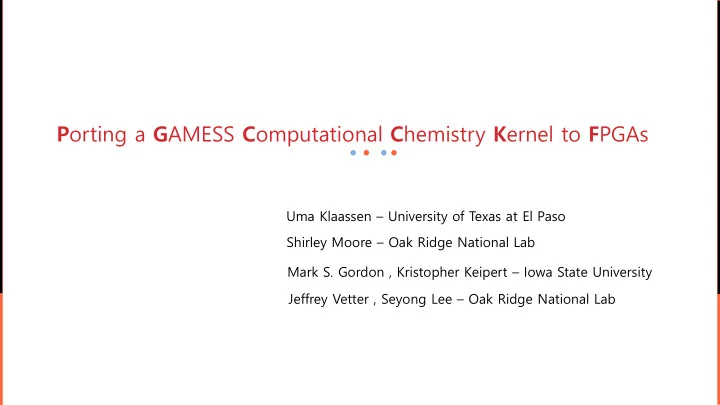

P orting a G AMESS C omputational C hemistry K ernel to F PGAs Uma Klaassen – University of Texas at El Paso Shirley Moore – Oak Ridge National Lab Mark S. Gordon , Kristopher Keipert – Iowa State University Jeffrey Vetter , Seyong Lee – Oak Ridge National Lab
1. Motivation Additional effort invested into integrating FPGA device programming to existing • workflows is significant for accelerating compute intensive kernels. Writing code for scientific applications in HDLs (Hardware Description Languages) • is complex. The OpenARC compiler provides easier FPGA programmability. • OpenARC translates OpenACC directive based code into OpenCL optimized for FPGAs. • The Intel OpenCL SDK converts OpenCL code to FPGA executable code. • OpenACC and other directive based programming models hide low level language • complexities.
2. Background We port a GAMESS kernel to FPGA enabled machines using OpenARC and • evaluate the performance results. GAMESS computational chemistry kernel contains the Hartree-Fock procedure. • The GAMESS-SIMINT Hartree-Fock quantum chemistry method computations • Compute molecular properties • A starting point for higher accuracy, for more computationally demanding methods. • The computational bottleneck of the Hartree-Fock procedure • Construction of the Fock matrix. • Requires computation of many electron repulsion integrals (ERIs). • The SIMINT integral package is a highly vectorized, high performance implement • ation of the Obara-Saika ERI evaluation method.
3. Methodology OpenARC takes only C code as input. • We translated the GAMESS-SIMGMS kernel to pure C code by hand. • We then inserted OpenACC directives to parallelize the code. • We used OpenARC to transform the code into OpenCL optimized for FPGAs. • Intel SDK for OpenCL compiles the code to an FPGA executable. •
4. Results Figure 1 compares execution times of the kernel with increasing problem size. • Problem size is the number of basis set functions, on a Nallatech Stratix V FPGA accelerator • board and on an Intel(R) Xeon(R) E5520 CPU. Figure 2 indicates the speedup achieved for different problem sizes. • We achieve up to 9.5X speedup on the FPGA. • The tested FPGA (Stratix V) does not contain dedicated floating point cores but the floating • point units are synthesized from existing building blocks. Figure 2: Speedup obtained on FPGA vs. CPU. Figure 1: Runtime on FPGA vs. CPU (logarithmic scale). .
5. Future/Ongoing work We plan to measure the speedup on the newer Nallatech Arria 10, which has • hardened floating point units and thus offers higher floating point performance. We will also use the Intel SDK Quartus power estimation tool to estimate power • consumption and will compare power and energy consumption of the CPU and FPGA implementations. Figure 2: Speedup obtained on FPGA vs. CPU. Figure 1: Runtime on FPGA vs. CPU (logarithmic scale). . .
Questions? Thank you!
Recommend
More recommend